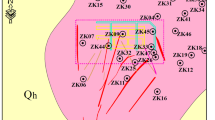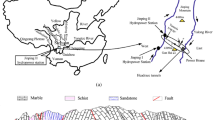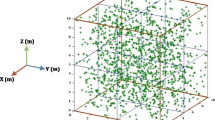Abstract
The main purpose of this study is to determine the appropriate grouting pattern for sealing the fractures of the Kerman Water Conveyance Tunnel (KWCT) using the discrete fracture network-discrete element method (DFN-DEM) and analytical approaches. In the first stage, nine DFNs were generated with different fracture densities. Following that, the hydraulic conductivity values were calculated to determine the representative elementary volume (REV) of a geological section of the KWCT. The grout’s effective radius in the optimal size blocks was then determined. Analytical models based on joint features and different rheological properties of the grout were also used to evaluate the grout penetration length. Finally, the most suitable patterns of grouting boreholes in rock masses with low and high fracture densities at a pressure of 24 bar were obtained by borehole arrangement with angles of 60° and 45°, respectively. These patterns were effectively used as the optimal injection arrangement in a zone of the KWCT that was at high risk of water inrush. Following the grouting, some core samples were drilled to assess the grouting efficiency and check the condition of the solidified grout in the rock mass cracks. According to the observations, the proposed arrangements were extremely efficient.
























Similar content being viewed by others
Data Availability
All data generated and analyzed during this study are included in this article.
References
Mao D, Lu M, Zhao Z, Ng M (2016) Effects of water related factors on pre-grouting in hard rock tunnelling. Procedia Eng 165:300–307. https://doi.org/10.1016/j.proeng.2016.11.704
Kim H-M, Lee J-W, Yazdani M et al (2018) Coupled viscous fluid flow and joint deformation analysis for grout injection in a rock joint. Rock Mech Rock Eng 51:627–638. https://doi.org/10.1007/s00603-017-1339-3
Stille H (2015) Rock grouting: theories and applications. BeFo-Rock Engineering Research Foundation, Stockholm
Ma H, Yin L, Gong Q, Wang J (2015) TBM tunneling in mixed-face ground: problems and solutions. Int J Min Sci Technol 25:641–647. https://doi.org/10.1016/j.ijmst.2015.05.019
Tóth Á, Gong Q, Zhao J (2013) Case studies of TBM tunneling performance in rock–soil interface mixed ground. Tunn Undergr Sp Technol 38:140–150. https://doi.org/10.1016/j.tust.2013.06.001
Zhao J, Gong QM, Eisensten Z (2007) Tunnelling through a frequently changing and mixed ground: a case history in Singapore. Tunn Undergr Sp Technol 22:388–400. https://doi.org/10.1016/j.tust.2006.10.002
Kobayashi S, Stille H (2007) Design for rock grouting based on analysis of grout penetration. Verification using Äspö HRL data and parameter analysis. Swedish Nuclear Fuel and Waste Management Co
Ghafar AN, Mentesidis A, Draganovic A, Larsson S (2016) An experimental approach to the development of dynamic pressure to improve grout spread. Rock Mech Rock Eng 49:3709–3721. https://doi.org/10.1007/s00603-016-1020-2
Butrón C, Gustafson G, Fransson Å, Funehag J (2010) Drip sealing of tunnels in hard rock: a new concept for the design and evaluation of permeation grouting. Tunn Undergr Sp Technol 25:114–121. https://doi.org/10.1016/j.tust.2009.09.008
Saeidi O, Stille H, Torabi SR (2013) Numerical and analytical analyses of the effects of different joint and grout properties on the rock mass groutability. Tunn Undergr Sp Technol 38:11–25. https://doi.org/10.1016/j.tust.2013.05.005
Mortazavi A, Maadikhah A (2016) An investigation of the effects of important grouting and rock parameters on the grouting process. Geomech Geoeng 11:219–235. https://doi.org/10.1080/17486025.2016.1145255
Mohajerani S, Baghbanan A, Wang G, Forouhandeh SF (2017) An efficient algorithm for simulating grout propagation in 2D discrete fracture networks. Int J Rock Mech Min Sci 98:67–77. https://doi.org/10.1016/j.ijrmms.2017.07.015
Zou L, Håkansson U, Cvetkovic V (2019) Cement grout propagation in two-dimensional fracture networks: impact of structure and hydraulic variability. Int J Rock Mech Min Sci 115:1–10. https://doi.org/10.1016/j.ijrmms.2019.01.004
Gustafson G, Claesson J, Fransson Å (2013) Steering parameters for rock grouting. J Appl Math 2013:1–9. https://doi.org/10.1155/2013/269594
Zou L, Håkansson U, Cvetkovic V (2018) Two-phase cement grout propagation in homogeneous water-saturated rock fractures. Int J Rock Mech Min Sci 106:243–249. https://doi.org/10.1016/j.ijrmms.2018.04.017
Janson T, Stille H, Hakansson U (1994) Grouting of jointed rock-a case study, Department of Soil and Rock Mechanics, Royal Institute of Technology. Stock Sweden
Khani A, Baghbanan A, Hashemolhosseini H (2013) Numerical investigation of the effect of fracture intensity on deformability and REV of fractured rock masses. Int J Rock Mech Min Sci. https://doi.org/10.1016/j.ijrmms.2013.08.006
Lei Q, Latham J-P, Tsang C-F (2017) The use of discrete fracture networks for modelling coupled geomechanical and hydrological behaviour of fractured rocks. Comput Geotech 85:151–176. https://doi.org/10.1016/j.compgeo.2016.12.024
Karbalaei MA, Katibeh H (2009) Cement grouting in Rocks. Tarava, Ahvaz (In Persian)
Zhang X, Sanderson DJ, Harkness RM, Last NC (1996) Evaluation of the 2-D permeability tensor for fractured rock masses. Int J Rock Mech Min Sci Geomech Abstr 33:17–37. https://doi.org/10.1016/0148-9062(95)00042-9
Wilkinson WL (1960) Non-Newtonian fluids: fluid mechanics, mixing and heat transfer. Pergamon Press, London
Dalmalm T (2004) Choice of grouting method for jointed hard rock based on sealing time predictions. Doctoral dissertation, Department of Civil and Architectural Engineering, Royal Institute of Technology
Eriksson M, Stille H (2005) Cementinjektering i hart berg (In Swedish). SveBeFo Report K22, Swedish Rock Engineering Research, Stockholm
Gustafson G, Stille H (2005) Stop criteria for cement grouting. Felsbau 23:62–68
Gholizadeh H, Peely AB, Karney BW, Malekpour A (2020) Assessment of groundwater ingress to a partially pressurized water-conveyance tunnel using a conduit-flow process model: a case study in Iran. Hydrogeol J 28:2573–2585. https://doi.org/10.1007/s10040-020-02213-y
Barton N, Bandis S, Bakhtar K (1985) Strength, deformation and conductivity coupling of rock joints. Int J Rock Mech Min Sci Geomech Abstr 22:121–140. https://doi.org/10.1016/0148-9062(85)93227-9
Olsson R, Barton N (2001) An improved model for hydromechanical coupling during shearing of rock joints. Int J rock Mech Min Sci 38:317–329. https://doi.org/10.1016/S1365-1609(00)00079-4
Rosquoët F, Alexis A, Khelidj A, Phelipot A (2003) Experimental study of cement grout: rheological behavior and sedimentation. Cem Concr Res 33:713–722. https://doi.org/10.1016/S0008-8846(02)01036-0
El Tani M (2012) Grouting rock fractures with cement grout. Rock Mech rock Eng 45:547–561. https://doi.org/10.1007/s00603-012-0235-0
Min K-B, Jing L, Stephansson O (2004) Determining the equivalent permeability tensor for fractured rock masses using a stochastic REV approach: method and application to the field data from Sellafield, UK. Hydrogeol J 12:497–510. https://doi.org/10.1007/s10040-004-0331-7
Baghbanan A, Jing L (2007) Hydraulic properties of fractured rock masses with correlated fracture length and aperture. Int J Rock Mech Min Sci 44:704–719. https://doi.org/10.1016/j.ijrmms.2006.11.001
ISRM (1978) suggested methods for the quantitative description of discontinuities in rock masses. Int J Rock Mech Min Sci Geomech Abstr 15:319–368. https://doi.org/10.1016/0148-9062(78)91472-9
Bandis SC, Lumsden AC, Barton NR (1983) Fundamentals of rock joint deformation. Int J Rock Mech Min Sci Geomech Abstr 20:249–268. https://doi.org/10.1016/0148-9062(83)90595-8
Barton N, Quadros E (2019) Understanding the need for pre-injection from permeability measurements: what is the connection? J Rock Mech Geotech Eng 11:576–597. https://doi.org/10.1016/j.jrmge.2018.12.008
Zhang D, Fang Q, Lou H (2014) Grouting techniques for the unfavorable geological conditions of Xiang’an subsea tunnel in China. J Rock Mech Geotech Eng 6:438–446. https://doi.org/10.1016/j.jrmge.2014.07.005
Attneave F, Arnoult MD (1956) The quantitative study of shape and pattern perception. Psychol Bull 53:452. https://doi.org/10.1037/h0044049
Dou J, Zhang G, Zhou M et al (2020) Curtain grouting experiment in a dam foundation: case study with the main focus on the Lugeon and grout take tests. Bull Eng Geol Environ 79:4527–4547. https://doi.org/10.1007/s10064-020-01865-0
Author information
Authors and Affiliations
Corresponding author
Ethics declarations
Conflict of Interest
The authors declare that they have no known competing financial interests or personal relationships that could have appeared to influence the work reported in this paper.
Additional information
Publisher's Note
Springer Nature remains neutral with regard to jurisdictional claims in published maps and institutional affiliations.
Rights and permissions
Springer Nature or its licensor (e.g. a society or other partner) holds exclusive rights to this article under a publishing agreement with the author(s) or other rightsholder(s); author self-archiving of the accepted manuscript version of this article is solely governed by the terms of such publishing agreement and applicable law.
About this article
Cite this article
Ghorbani, S., Bour, K., Javdan, R. et al. Design of Effective Grouting Pattern in Kerman Water Conveyance Tunnel Using DFN-DEM and Analytical Approaches. Int. J. of Geosynth. and Ground Eng. 9, 19 (2023). https://doi.org/10.1007/s40891-023-00441-2
Received:
Accepted:
Published:
DOI: https://doi.org/10.1007/s40891-023-00441-2




